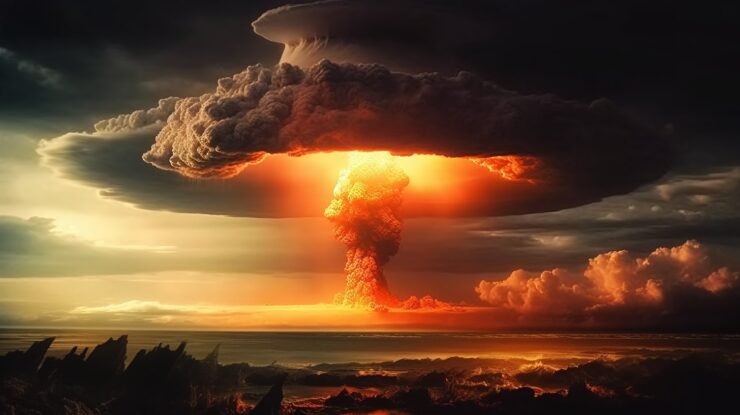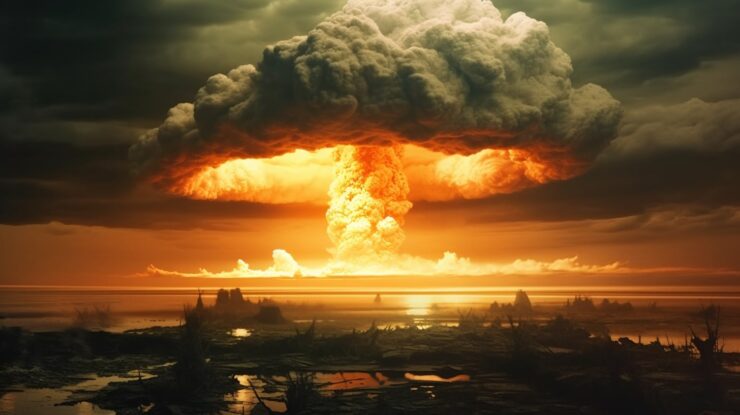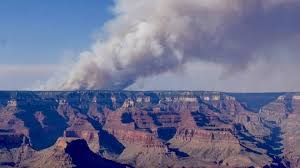A nuclear weapon, often termed an atomic or nuclear bomb, is a formidable explosive that harnesses the immense power of nuclear fission, fusion, or both. These devices are sometimes referred to as A-bombs, nukes, or nuclear warheads. Broadly, they fall into two categories: those driven by fission and those that combine fission with the even more potent fusion process, known as thermonuclear or H-bombs.
The explosive force of these weapons is quantified in kilotons (equivalent to 1,000 tons of TNT) and megatons (equivalent to 1,000,000 tons of TNT), accompanied by intense heat and radiation. Undoubtedly, they rank as the most intimidating armaments in existence, with the potential to cause unparalleled devastation and harm.
Current State of Global Nuclear Weaponry
Today’s world houses an estimated 13,080 nuclear warheads, a significant reduction from the zenith of the U.S. and Russia’s Cold War arsenals. However, the nuclear landscape has evolved, with more nations now possessing these weapons than three to four decades ago.
Russia currently leads the tally with around 6,257 warheads. Breaking this down: 1,458 are on active duty (with the START II treaty capping both the U.S. and Russia at 1,550 deployed warheads), 3,039 are in reserve but can be activated, and 1,760 are set to be decommissioned. The U.S. is a close second, boasting 5,550 warheads: 1,389 in active service, 2,361 on standby, and 1,800 queued for dismantlement.
Which Countries Have Nuclear Weapons?
- Russia — 6,257 (1,458 active, 3039 available, 1,760 retired)
- United States — 5,550 (1,389 active, 2,361 available, 1,800 retired)
- China — 350 available (actively expanding nuclear arsenal)
- France — 290 available
- United Kingdom — 225 available
- Pakistan — 165 available
- India — 156 available
- Israel — 90 available
- North Korea — 40-50 available (estimated)
Nuclear Bombs Dropped During World War II

Historically, only two instances exist where nuclear weapons were deployed in warfare. In the concluding moments of World War II, the U.S. released two atomic bombs on Japan, “Little Boy” and “Fat Man”. The first, named “Little Boy,” was unleashed upon Hiroshima on August 6, 1945. Its explosive might, equivalent to 15 kilotons, obliterated structures within a mile’s radius.
This initial devastation was succeeded by a searing heatwave of 6,000°C (10,830°F), setting aflame anything combustible and transforming the impact area into a raging inferno.
The explosion’s aftermath also brought forth deadly ionizing radiation and a prolonged radioactive fallout. This fallout consisted of debris propelled into the stratosphere during the explosion, which then gradually descended back to Earth over subsequent days. A 1945 official report estimated Hiroshima’s casualties to be around 66,000 fatalities and an additional 69,000 injuries.
Three days later, on August 9, 1945, a second bomb, “Fat Man,” was dropped on Nagasaki, causing an estimated 39,000 deaths and 25,000 injuries, a grim testament to the weapon’s destructive power.
The Cold War
Post the cataclysmic events in Hiroshima and Nagasaki, nuclear weapons were cemented as the pinnacle of military might, sparking an intense arms race between the U.S. and the Soviet Union.
In 1945, Setsuko Thurlow was a thirteen-year-old girl living in Hiroshima. She recalled the nuclear attack for a special issue of #ArmsControlToday.
Read her chilling account at https://t.co/3Z7uvBWa0N pic.twitter.com/zYL9di5kvM
— Arms Control Assoc (@ArmsControlNow) August 6, 2024
This silent competition, emblematic of the Cold War era, saw both superpowers amassing nuclear arsenals without formally declaring war on each other. The zenith of this race was in 1986, as cited by the Bulletin of Atomic Scientists, with the Soviet Union boasting over 40,000 nuclear warheads and the U.S. holding 23,000, a decrease from its peak of 31,000 in 1967.
Central to this accumulation was the doctrine of “mutually assured destruction.” This principle posited that the sheer volume of nuclear weapons on each side would deter any first strikes, as neither could hope to decimate the other’s arsenal sufficiently to avoid a catastrophic counterattack. The dissolution of the Soviet Union in 1991 marked the decommissioning of thousands of these warheads.
International Pacts to Curb Nuclear Proliferation
Given the unparalleled devastation nuclear weapons can wreak, nations globally have sought to curtail their proliferation through various treaties. Key among these are:
- Nuclear Non-Proliferation Treaty (NPT) 1970: A cornerstone of nuclear disarmament, the NPT aims to prevent the spread of nuclear weapons. It categorizes five nations as nuclear-weapon states (NWS) – the U.S., Russia, China, France, and the UK, with the rest being non-nuclear weapon states (NNWS). The treaty mandates NWS not to assist NNWS in acquiring nuclear weapons, while NNWS commit to not pursuing them independently. Additionally, all signatories pledge to collaborate on harnessing nuclear energy for peaceful endeavors and to earnestly negotiate nuclear disarmament.
- Strategic Arms Limitation Treaty (SALT) 1972: This treaty was instrumental in capping the number of ballistic missile launchers either superpower could possess.
- Strategic Arms Reduction Treaty (START) 1991: A significant step towards disarmament, START aimed at reducing the nuclear arsenals of both the U.S. and the Soviet Union.
As of 2022, the NPT had been ratified by nearly every nation, with North Korea being a notable exception, having exited the treaty in 2003.
Here are the 10 countries with the most nuclear weapons:
- Russia: 6,257 🇷🇺
- United States: 5,550 🇺🇸
- China: 350 🇨🇳
- France: 290 🇫🇷
- United Kingdom: 225 🇬🇧
- Pakistan: 165 🇵🇰
- India: 156 🇮🇳
- Israel: 90 🇮🇱
- North Korea: 50 🇰🇵
| Country | Total Weapons | Active | Available | Retired |
|---|---|---|---|---|
| Russia | 6,257 | 1,458 | 3,039 | 1,760 |
| United States | 5,550 | 1,389 | 2,361 | 1,800 |
| China | 350 | 350 | ||
| France | 290 | 290 | ||
| United Kingdom | 225 | 225 | ||
| Pakistan | 165 | 165 | ||
| India | 156 | 156 | ||
| Israel | 90 | 90 | ||
| North Korea | 50 | 50 |
Final Words
As we stand at the crossroads of history, the presence of nuclear weapons continues to shape global politics and security dynamics. The 2024 landscape underscores the importance of diplomatic efforts and international treaties in ensuring a safer world.
While the numbers and capabilities might change, the underlying message remains clear: the pursuit of peace and disarmament is more crucial than ever. As global citizens, understanding these dynamics is the first step towards advocating for a world free from the shadow of nuclear threats.












